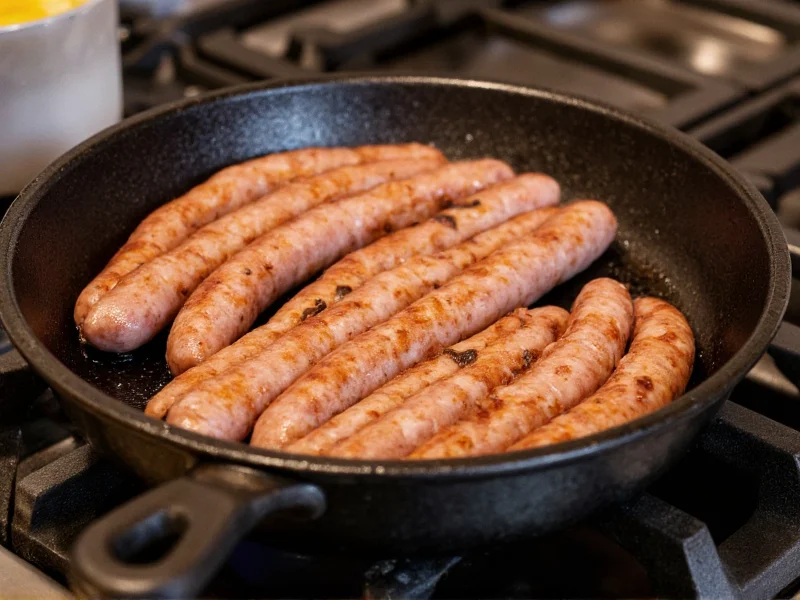Making sausage at home might seem intimidating, but with the right technique, your stovetop can produce restaurant-quality results. Unlike store-bought varieties filled with preservatives, homemade sausage lets you control ingredients and customize flavors to your preference. The stovetop method offers precise temperature control that's essential for proper meat cooking without drying out your sausage.
Essential Ingredients and Equipment
Before you begin, gather these fundamental components. Quality ingredients make the difference between mediocre and exceptional sausage. For beginners, pork shoulder (also called pork butt) provides the ideal 70% lean to 30% fat ratio that keeps sausage moist during cooking.
| Ingredient | Recommended Amount | Purpose |
|---|---|---|
| Ground meat (pork/beef/chicken) | 2 lbs | Main protein base |
| Cold water or broth | ¼ cup | Helps bind ingredients |
| Salt | 1½ tsp | Essential for flavor and protein extraction |
| Freshly ground black pepper | 1 tsp | Basic seasoning |
| Garlic powder | 1 tsp | Flavor enhancer |
For equipment, you'll need a cast iron or stainless steel skillet (avoid non-stick for proper browning), meat thermometer, mixing bowl, and measuring spoons. A sausage stuffer is helpful but not essential for basic patties.
Step-by-Step Stovetop Sausage Preparation
Follow these professional techniques to achieve perfectly cooked sausage every time. Temperature control separates good sausage from great sausage.
1. Prepare Your Meat Mixture
Keep all ingredients cold until mixing. Combine ground meat with salt, pepper, and your chosen seasonings in a bowl. Mix gently with your hands for 2-3 minutes until the mixture becomes slightly sticky—this indicates protein extraction which helps bind the sausage. Overmixing creates tough sausage, while undermixing leads to crumbly results.
2. Form Your Sausage
For patties: Divide mixture into 4-ounce portions and shape into ½-inch thick discs. For links: Roll mixture into a log and divide into 4-inch segments, then twist ends. Proper shaping prevents uneven cooking.
3. Preheat Your Skillet Properly
Place your empty skillet on medium heat for 3-5 minutes. Test readiness by sprinkling a few drops of water—if they dance and evaporate within 1-2 seconds, your pan is at the ideal 325-350°F temperature range. Adding oil isn't necessary with fatty meats, but use 1 tablespoon of high-smoke point oil (avocado or canola) for leaner varieties.
4. Cook with Precision
Place sausages in the preheated skillet without crowding. Cook for 4-5 minutes per side for patties, or roll links every 3-4 minutes. The critical mistake many home cooks make is turning sausage too frequently—allow proper sear development by limiting turns to 3-4 times total. Never pierce sausage with a fork, as this releases precious juices.
5. Check Internal Temperature
After 10 minutes of cooking, insert a meat thermometer into the thickest part. Pork and beef sausages need to reach 160°F, while poultry varieties require 165°F. If temperature hasn't been reached, reduce heat slightly and continue cooking, checking every 2 minutes. Remember that sausage continues cooking from residual heat after removal from the pan.
Safety Considerations for Stovetop Sausage Making
Proper food safety prevents illness and ensures delicious results. Always handle raw meat with care:
- Keep meat refrigerated below 40°F until ready to use
- Wash hands thoroughly before and after handling raw meat
- Clean all surfaces and utensils with hot, soapy water after contact with raw meat
- Never place cooked sausage back on plates that held raw meat
- Use a calibrated meat thermometer—color alone doesn't indicate doneness
The danger zone for meat is between 40°F and 140°F, where bacteria multiply rapidly. Minimize time in this range by moving efficiently from preparation to cooking. Cooked sausage should spend no more than 2 hours at room temperature before refrigeration.
Troubleshooting Common Stovetop Sausage Problems
Even experienced cooks encounter issues. Here's how to solve frequent challenges when making sausage on the stove:
Burning Before Cooking Through
This happens when heat is too high. Solution: Start with medium-low heat (300°F) and gradually increase if needed. If browning too quickly, add 2 tablespoons of water to the pan and cover briefly to create steam that cooks the interior.
Greasy Results
Excess grease indicates improper fat rendering. Solution: Cook at consistent medium heat rather than high heat, which causes fat to burst out instead of rendering slowly. Drain excess grease only after sausage is nearly cooked through.
Crumbling Patties
Insufficient binding causes this. Solution: Ensure proper salt content (1.5% of meat weight) and mix until slightly sticky. Adding ¼ cup cold water or broth during mixing improves cohesion without diluting flavor.
Flavor Variations to Try
Once you've mastered the basic technique, experiment with these popular flavor profiles. The beauty of homemade sausage is complete customization:
- Italian Style: Add 1 tablespoon fennel seeds, 2 teaspoons dried oregano, and ½ teaspoon red pepper flakes
- Breakfast Sausage: Mix in 1 teaspoon maple syrup, ½ teaspoon sage, and ¼ teaspoon nutmeg
- Chorizo: Incorporate 1 tablespoon smoked paprika, 1 teaspoon cumin, and 2 minced garlic cloves
- Chicken Apple: Combine with ½ cup finely diced apple and 1 teaspoon thyme
For best flavor development, refrigerate the mixture for 12-24 hours before cooking to allow seasonings to penetrate the meat. This simple step transforms good sausage into exceptional sausage.
Serving and Storage Recommendations
Serve immediately for best texture and flavor. Pair with traditional sides like sautéed peppers and onions, mashed potatoes, or crusty bread. Leftovers should cool completely within 2 hours, then store in airtight containers.
Refrigerated sausage keeps for 3-4 days. For longer storage, freeze in portion-sized containers for up to 3 months. When reheating, use a skillet over medium-low heat rather than microwave to preserve texture. Add a splash of water or broth to prevent drying during reheating.











 浙公网安备
33010002000092号
浙公网安备
33010002000092号 浙B2-20120091-4
浙B2-20120091-4